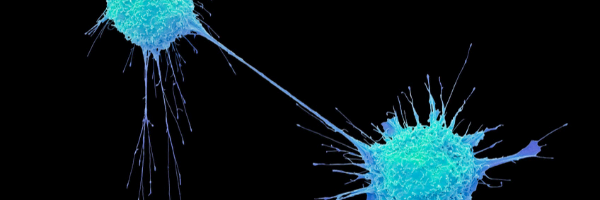Dendritic cells help the immune system recognize and destroy foreign invaders or rogue cancer cells. Like a sentry on the battlefield, dendritic cells are highly skilled professionals on the lookout for trouble. They specialize in presenting specific protein markers called antigens or epitopes to other parts of the immune system, sounding the alarm for the immune system to gear up for battle. This activates T-cells and other front line immune cells to attack and stimulates B-cells to make antibodies to seek out and destroy cells or pathogens that carry the specific antigen.
Dendritic cell therapy harnesses the power of dendritic cells by exposing them to circulating tumor cells from the blood of a patient with cancer, focusing the dendritic cells on antigen targets from the cancer cells. The dendritic cell population is then multiplied into millions of immune sentries and infused back into the patient. This stimulates the immune system to ramp up the attack on the cancer and also provides a long lasting immune memory that will keep the system vigilant in fighting the cancer.
The goal of dendritic cell therapy is to prime dendritic cells to teach T cells and B cells how to recognize the cancer antigens. Eventually, specialized cells form memory to teach new dendritic cells this same execution. If the therapy is effective, it will give the patient long-term immunity against the cancer cells.
Dendritic Cell Therapy (DCT)
When dealing with a complex cancer therapy, timing is of the essence. Dendritic cells engage the native immune system of the patient and allow the immune system to target the best antigens or the best range of antigens it encounters. In stage 1 and 2 cancers the immune system is still in good shape and it can create a good immune response that is sustainable.
VAXO-Q-RE
With Dendritic cells, the advantage is the choice of the antigens was randomly picked by the immune system so when new mutations occur the matrix is already there. But, cancer is adaptable and is always working to mutate, employ new survival mechanisms, etc. so the antigen targets change. You lose the random advantage when a patient has more advanced cancer (stage 3 or above). In this case the antigen targets need to be re-arranged and new antigens developed. This is the VAXO-Q-RE process in which the best choice of antigens comes from the scientific knowledge of the scientists.
Immune Frame
DCT and VAXO-Q-RE is offered through Research Genetics Cancer Center (RGCC) Group, established in 2004 by Dr. Ioannis Papasotiriou. The company is a pioneering, innovative organization working in the fields of medical genetics and, in particular, cancer genetics, chemosensitivity and chemo-resistance testing and in research and development within the pharmaceutical industry via RGCC Pharma Ltd. The company headquarters are in Switzerland, and the brand new, state-of-the art laboratories in Northern Greece are equipped with the most up-to-date technological, advanced and innovative equipment. Dr Rollins has been using the RGCC tests and therapies since 2013 and has trained extensively with RGCC.
In order to receive DCT or VAXO-Q-RE an initial blood draw for circulating tumor cells (must be oncotrace) and immune frame. We wait for those results to confirm the patient is elegible for therapy, then another draw for the dendritic cells is done. When the dendritic cell therapy arrives (day 1) the first infusion is done, and then repeated on day 21 and day 42. On day 63 the immune frame and oncotrace panel is repeated.
The risks of DCT or VAXO-Q-RE infusions are primarily related to the sudden death of the cancer cells. If there is a large tumor burden then the cell death may produce a large amount of dead cellular debris leading to tumor lysis syndrome. A recent PET/CT scan is recommended prior to treatment treatment in order to gauge current tumor burden. We generally avoid these treatments if the total body tumor burden is more than 125 cubic cm.
Aside from tumor size/burden, the location of tumor may also increase risk. For example, if the tumor is in the brain or lung, then the sudden die-off may produce inflammation and fluid accumulation in the region. This might lead to seizures, or fluid accumulation in the lung space that would need to be drained.
The DCT is about $10,500, immune frame $1,400, and oncotrace $1,450, bringing the total treatment cost to around $13,350. The VAXO-Q-RE is about $10,000. This is in Euros and varies slightly.
Immune Frame Goals
Pretreatment
- Tregs (CD25 + CTLA4) as low as possible on the pre-Immune Frame
- Low TNF-a on the pre–Immune Frame (must be under 5%)
Monitoring progress / signs of memory activation
- Any rise of markers except for CD25, CTLA4 and TNF-a is an indication of activation
- T&B cells should be steadily present
- CD 80 should be over 15%
- CD 86 should be over 10%
- CD 28 – B & T line should be above 0 (even barely ok)
Ultimate Goal
- >22 on both CD80 & CD86 memory cells
- >1.0 on CD28 memory cells
Additional Resources
Dendritic cell therapy in cancer treatment; the state-of-the-art


